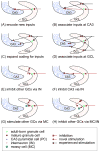Ongoing interplay between the neural network and neurogenesis in the adult hippocampus
- PMID: 20079627
- PMCID: PMC2837845
- DOI: 10.1016/j.conb.2009.12.008
Ongoing interplay between the neural network and neurogenesis in the adult hippocampus
Abstract
As a unique form of structural plasticity in the central nervous system, adult neurogenesis in the hippocampus alters network functions by continuously adding new neurons to the mature network, while at the same time is subjected to regulation by surrounding network activity. Here, we review the recently identified mechanisms through which network activity exerts its impacts on multiple steps of adult neurogenesis in rodents and culminates in the selective recruitment of new neurons. We also review recent progress on the study of cellular connectivity modified by new neurons in the dentate gyrus and its physiological functions in rodents. We believe that understanding these processes will allow eventual elucidation of the mechanisms controlling the development of balanced inputs and outputs for the adult-born neurons and reveal important insights into the cellular organization of learning and memory.
2010 Elsevier Ltd. All rights reserved.
Figures




References
-
- Zhao C, Deng W, Gage FH. Mechanisms and functional implications of adult neurogenesis. Cell. 2008;132:645–660. This is a thorough and updated review on adult neurogenesis in general. - PubMed
-
- Deisseroth K, Singla S, Toda H, Monje M, Palmer TD, Malenka RC. Excitation-neurogenesis coupling in adult neural stem/progenitor cells. Neuron. 2004;42:535–552. - PubMed
Publication types
MeSH terms
Grants and funding
LinkOut - more resources
Full Text Sources
Research Materials

